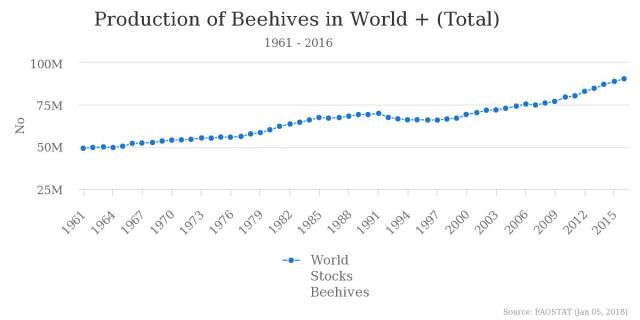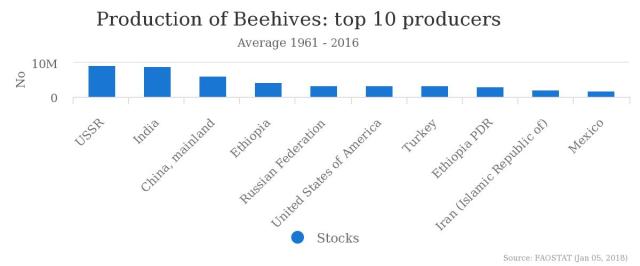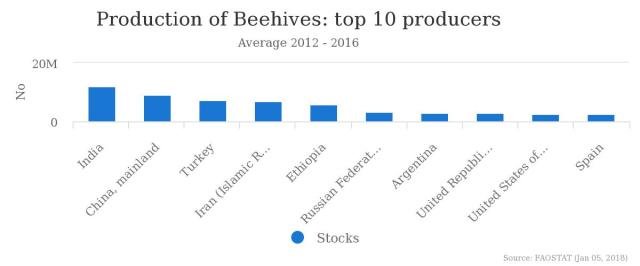EDIT 2019 – see my latest post How many honey bees are there? A 2019 update for more recent figures.
“How many honey bees are there?” – an answer for Quora
I rarely answer questions on the Q&A website Quora nowadays, on account of having no spare time, but I was asked to answer this one and it got me intrigued about whether any kind of data exists on this. Would anyone really have counted?
Well, it turns out they have… sort of.
At the United Nations Food and Agriculture Organization website, FAOSTAT, you can download the latest 2016 data on the number of managed bee hives worldwide across 123 countries. The individual country data can be downloaded as a juicy detailed spreadsheet or the data can be visualised in attractive graphs for you at FAOSTAT – this tells us that there was a worldwide total of 90,564,654 beehives in 2016.

© FAO, Production of Beehives world total 1961-2016, Web address: http://www.fao.org/faostat/en/#data/QA/visualize, Accessed: 05/01/18
But we want to know the total number of honey bees, not just honey bee hives. Of course the number of honey bees in a hive fluctuates during the year depending on the local weather, season, available forage and the health of the colony. The species or sub-species of honey bee will also affect how many bees are in a colony. I’ve seen vastly wide ranging estimates of how many bees are in a colony, but the British Beekeeping Association (BBKA) ‘Life in the hive’ information sheet says ‘In high summer about 35,000, dropping to around 5,000 in the winter’, so let’s go with that. As a very rough and un-mathematical estimate we might say around 20,000 bees could be in each colony. So 90,564,654 x 20,000, which my calculator says = 1.8112931e+12
But this number is only for bee hives that have been counted and the data supplied to the United Nations. The spreadsheet says the data is ‘Aggregate, may include official, semi-official, estimated or calculated data’. One can imagine its accuracy may vary widely from country to country! Unless anyone was clambering up every tree or chimney counting colonies, there will be many more wild colonies that have not been included. And the number of live honey bee colonies will be fluctuating all the time.
Despite the gloomy media reports about declining honey bee numbers, I hope these estimates persuade you that honey bees are not facing the same predicament as the Javan rhino (58-68 left). Indeed the long-term trend over the past half-century seems to indicate that the number of hives globally is increasing.
This trend was picked up on by Katherine Harmon in her 2009 Scientific American article Growth Industry: Honeybee Numbers Expand Worldwide as U.S. Decline Continues. She mentions an increase of 45% in domesticated honeybee populations over the 50 years of FAOSTAT data studied by researchers Marcelo A. Aizen and Lawrence D. Harder for their 2009 Current Biology journal paper (The Global Stock of Domesticated Honey Bees Is Growing Slower Than Agricultural Demand for Pollination). Yet despite this growth, it’s still dwarfed by the >300% increase in agricultural crops that rely on animal pollination. Aizen and Harder say, ‘The main exceptions to this global increase involve long-term declines in the USA and some European countries, but these are outweighed by rapid growth elsewhere’.

© FAO, Production of Beehives: top ten producers 1961-2016, Web address: http://www.fao.org/faostat/en/#data/QA/visualize, Accessed: 05/01/18
We can see that over the past five years India, China and Turkey now take the top spots for bee hive stocks.

© FAO, Production of Beehives: top ten producers 2012-2016, Web address: http://www.fao.org/faostat/en/#data/QA/visualize, Accessed: 05/01/18
Of course, now that I’ve attempted to answer the question it will probably turn out the questioner was asking an entirely different question. Maybe they just wanted to know the number of honey bee species there are. The first rule of answering any enquiry is to pin down what the question really is, as it often turns out to be something entirely different from what you thought. And sometimes the person asking isn’t entirely sure what they want either.
Anyway, Happy New Year!
EDIT: MerryBee left a comment below saying “Interesting article, Emily. Have you any idea while there seems to be no data on FAOSTAT for beehives in the UK after 1987?”
I’ve had a look too and found the same thing – for some reason our government no longer seems to be supplying the data to FAOSTAT. Which will make my global estimate even more inaccurate! The UK government does attempt to collect hive numbers through the National Bee Unit – according to their Hive Count page “Last year’s count indicated a total UK population of honey bee hives of approximately 223,000”.

I would also note that you focused on managed colonies, while the question was a general one. So your estimate of about 2 trillion honey bees worldwide could be low. Agree, though, that honey bees are not really threatened. It is the native bees that we need to worry about out. Most of the 20,000 bee species worldwide do not have beekeepers looking after them.
LikeLiked by 1 person
Thanks Erik, I agree it’s too low but I don’t know how to go about estimating the number of wild colonies.
LikeLiked by 1 person
Indeed. I think you simply round up to 2 trillion and call it a day. Really interesting estimate.
LikeLike
Pingback: How many honey bees are there? | Raising Honey Bees
Great article! I’ve never calculated the number of honey bees before – two trillion would make quite a swarm (and it would weigh over half a billion pounds!!
I’m glad that you mentioned Dr Harder’s paper on world-wide colony counts. Most people don’t realize that honey bees are increasing in number. Here in Canada, we have never had more hives than we do today. Here’s a chart for you:
LikeLiked by 1 person
It’s amazing isn’t it. Was beekeeping encouraged during the war and then declined in popularity for a while afterwards? What was behind its growth in popularity in the seventies and eighties?
LikeLike
Great questions!
1939-1946
During the war, sugar was rationed. Suddenly everyone wanted hives because they could get extra sugar rations to ‘feed the bees’ – but a lot of people neglected their bees. Most of those ‘beekeepers’ quit when sugar became easy to buy again after the war.
1972-1985
Through much of the period from the 20s through 1970, honey sold between 10 and 15 cents per pound. Around 1972, the wholesale price shot up to about 50 cents, making commercial beekeeping viable and holdings expanded. Suddenly there were many operations with over 1,000 hives. Before that, beekeepers with a few hundred colonies were ‘large-scale’ operators.
late 1980s
You’ll notice a big drop off around 1985. Tracheal mite had been found in the USA (then later varroa) and the main source of winter replacement bees (the USA) was abruptly closed by the Canadian government. That destroyed a lot of family farms across Canada because they had to buy replacements from Australia or New Zealand for much, much higher prices. Many couldn’t afford it and went broke. The drop had nothing to do with mites killing bees, but with the border closure. Mites eventually arrived in Canada through drift (and a few illegal imports) from across the border. Today, tracheal isn’t even monitored by beekeepers. Varroa mite is a big problem, but hive counts have gone up nevertheless.
2010-2015
The last spike you see is recent – wholesale honey prices went way up again, from under a dollar to around two dollars a pound, so beekeepers expanded their businesses.
Present
Recently, the price has begun to fall so I expect some reduction in hive numbers. However, we are getting more and more hobby beekeepers who are interested in maintaining pollinators and who are attracted to beekeeping in general.
Surprisingly, the fluctuations in colony counts are caused by either government rules or market (price) conditions.
LikeLiked by 1 person
Great history Ron, thank you! I remember reading about the tracheal mite and falling honey prices in your book.
LikeLiked by 1 person
Pingback: How many honey bees are there? | Beginner Beekeeper
In response to Erik above … he’s absolutely right, most native bees have no-one to (mis)manage them. However, most of them aren’t honey bees.
If the Q was actually about the number/range of honey bee species they could do a lot worse than reading the book Cueilleurs de Miel by Eric Tourneret and Sylla de Saint-Pierre – http://theapiarist.org/cueilleurs-de-miel/. They document ‘our’ honey bee, Apis mellifera, and some of the other species humans manage to collect honey from such as Trigona scaptotrigona, Apis laboriosa and Apis cerana. The book is illustrated with fabulous photographs.
LikeLiked by 1 person
That book is in my Amazon wish list, it looks beautiful.
LikeLike
Interesting article, Emily. Have you any idea while there seems to be no data on FAOSTAT for beehives in the UK after 1987 ?
LikeLike
I hadn’t spotted that! Was just looking at the worldwide totals. Will take a look tonight.
LikeLike
I’m finding the same thing. I can only presume that we have stopped supplying the data to FAOSTAT for some reason. Will update the post to reflect your discovery!
LikeLike
Thanks for this Emily, it’s good to see the supposition that honeybees are not under threat supported by data. I wish some of the pressure groups would be more nuanced in their statements about the threats to bees, the latest that comes to mind being “game over for the bees”.
LikeLike
I agree, the public automatically think these groups mean honey bees when in reality they’re the least threatened species. And sometimes the groups illustrate their campaigns with photos of honey bees, so no wonder people think they’re at risk.
LikeLike
Pingback: How many honey bees are there? A 2019 update. | Adventuresinbeeland's Blog